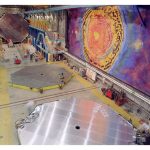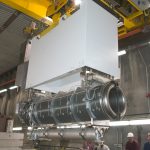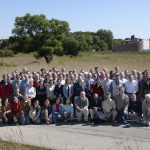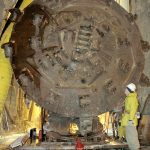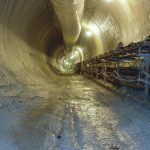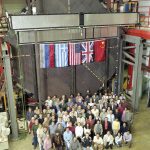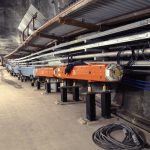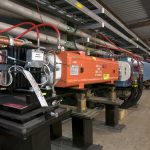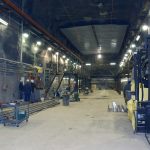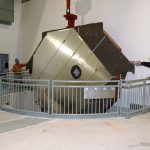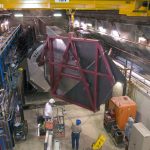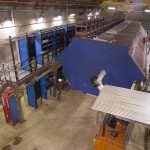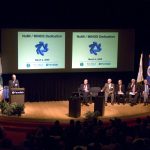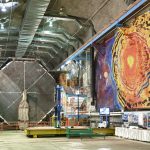New result indicates that the flavor and mass correlation may be more complex than previously thought.
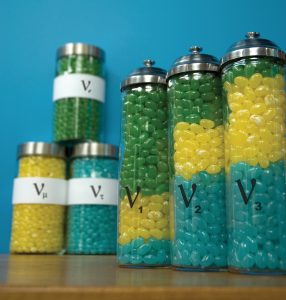
An illustration of the three neutrino mass states and the three flavors that make them up (electron, muon and tau), as they were previously though to mix. NOvA’s new result shows that the third mass state may not have equal amounts of muon (yellow jellybeans) and tau (blue jellybeans) flavors. Image: Fermilab/Sandbox Studios
Scientists from the NOvA collaboration have announced an exciting new result that could improve our understanding of the behavior of neutrinos.
Neutrinos have previously been detected in three types, called flavors – muon, tau and electron. They also exist in three mass states, but those states don’t necessarily correspond directly to the three flavors. They relate to each other through a complex (and only partially understood) process called mixing, and the more we understand about how the flavors and mass states connect, the more we will know about these mysterious particles.
As the collaboration will present today at the International Conference on High Energy Physics in Chicago, NOvA scientists have seen evidence that one of the three neutrino mass states might not include equal parts of muon and tau flavor, as previously thought. Scientists refer to this as “nonmaximal mixing,” and NOvA’s preliminary result is the first hint that this may be the case for the third mass state.
“Neutrinos are always surprising us. This result is a fresh look into one of the major unknowns in neutrino physics,” said Mark Messier of Indiana University, co-spokesperson of the NOvA experiment.
The NOvA experiment, headquartered at the U.S. Department of Energy’s Fermi National Accelerator Laboratory, has been collecting data on neutrinos since February 2014. NOvA uses the world’s most powerful beam of muon neutrinos, generated at Fermilab, which travels through the Earth 500 miles to a building-size detector in northern Minnesota. NOvA was designed to study neutrino oscillations, the phenomenon by which these particles “flip” flavors while in transit.
NOvA has been using the oscillations of neutrinos to learn more about their basic properties for two years. The NOvA detector is sensitive to both muon and electron neutrinos and can analyze the number of muon neutrinos that remain after traveling through the Earth and the number of electron neutrinos that appear during the journey.
The data also show that the third mass state might have more muon flavor than tau flavor, or vice versa. The NOvA experiment hasn’t yet collected enough data to claim a discovery of nonmaximal mixing, but if this effect persists, scientists expect to have enough data to definitively explore this mystery in the coming years.
“NOvA is just getting started,” said Gregory Pawloski of the University of Minnesota, one of the NOvA scientists who worked on this result. “The data sample reported today is just one-sixth of the total planned, and it will be exciting to see if this intriguing hint develops into a discovery.”
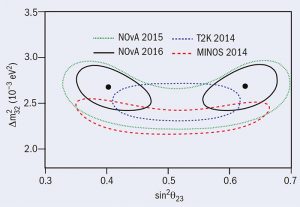
The NOvA experiment’s preliminary result shows an equal possibility that the third neutrino mass state is dominated by either muon or tau flavor. Image: NOvA collaboration
NOvA will take data with neutrinos and antineutrinos over the next several years. With both detectors running smoothly and Fermilab’s neutrino beam at full strength, the NOvA experiment is well positioned to illuminate many of the remaining neutrino mysteries.
The NOvA experiment is funded by the U.S. Department of Energy Office of Science, the National Science Foundation and other institutions worldwide.
For more information on NOvA, visit their website. To read a public presentation on this result, please visit this link.
Fermilab is America’s premier national laboratory for particle physics research. A U.S. Department of Energy Office of Science laboratory, Fermilab is located near Chicago, Illinois, and operated under contract by the Fermi Research Alliance LLC. Visit Fermilab’s website at http://www.fnal.gov and follow us on Twitter @Fermilab.
The DOE Office of Science is the single largest supporter of basic research in the physical sciences in the United States, and is working to address some of the most pressing challenges of our time. For more information, please visit http://science.energy.gov.
Media contact:
- Andre Salles, Fermilab Office of Communication, media@fnal.gov, 630-840-3351
Science contacts:
- Mark Messier, Indiana University, NOvA co-spokesperson, messier@indiana.edu, 812-855-0236
- Peter Shanahan, Fermilab, NOvA co-spokesperson, shanahan@fnal.gov, 630-840-8378
Jim Olsen of Princeton University, physics co-coordinator for CMS, was addressing a packed CERN auditorium — the same auditorium where the observation of the Higgs boson was announced just slightly less than four years earlier. His status report on the data analysis activities of the CMS Collaboration included a review of the schedule in preparation for the International Conference on High Energy Physics (ICHEP), which was due to start in Chicago on August 4.
I was sitting in the audience, reading the schedule from the projected slides:
- Approvals by July 22 (leaving time for top-ups)
- ARC Greenlight by July 15
- Pre-approval July 1 (10 days from today)
- Freezing by June 24 (this week!)
June 24? A full six weeks before the conference? And today was already June 20. (At least, I thought it was. I had just arrived from the U.S. a few hours earlier, and I was a little confused about the date.) It was going to be a short six weeks. The race to ICHEP was on.
But it wasn’t just a race — we also had what computer scientists call a “race condition.” This occurs when a system depends on the sequencing of events that occur at uncontrollable times. If the events occur in the wrong sequence, you can get the wrong result. In a computer program, it’s a bug that you want to fix. But in real life, race conditions are sometimes unavoidable.
In our case, one event was the approval of results that would be made public. Jim’s bullet points worked backwards from the conference date; my description will describe the approval process in the forward direction.
The runup to a result
Any new result from CMS is carefully evaluated before it is made public. There is a prescribed procedure and schedule for this, as described on Jim’s slide, to ensure that there is enough time for proper vetting. All measurements must be thoroughly documented, both in a document to be made available to the public (known in CMS as a “Physics Analysis Summary” or PAS) and another, longer document with more technical details for internal use (an “analysis note”). A data analysis usually evolves as the scientists understand their work better, but at some point it has to be finalized. In CMS, an analysis and its documentation must be “frozen” for an entire week before it can be reviewed. That gives collaborators enough time to read the documentation and ask questions about it.
After the freeze week, the proponents of a given measurement make a presentation of the work to the relevant “analysis group” within CMS, the population of CMS scientists who are interested in a given set of physics measurements (such as those in top quark physics or Higgs physics or supersymmetry searches). This is a chance for people to ask questions about the analysis in an open forum and identify any possible issues. If the measurement is judged to be in good enough shape, it is “preapproved,” which puts it on track for public release.
Analysis of an approval
Once the science analysis is preapproved, a separate committee of CMS scientists is appointed to perform an independent review of the analysis. This Analysis Review Committee (ARC) functions much like peer reviewers for a journal article. They are independent of the scientists who are performing the measurement but have some expertise in the topic such that they can evaluate the work (but aren’t expected to reproduce it themselves). The ARC is given a minimum of two weeks to evaluate the documentation, pose questions to the proponents and iterate with them to resolve any questions they may have. This is also an important phase for shaping message of the documentation that will be released to the public, which is needed to demonstrate to the world that the work is correct.
If the ARC review is successful, the committee “greenlights” the analysis for final approval by the collaboration. The approval presentation is similar to that of the preapproval (including the required one-week freeze of the documentation), but it also emphasizes any changes that were made during the ARC review and sometimes is made in a broader venue than that of the analysis group. If the approval is successful, then the result (and documentation) can be released to the public. Note that at any stage, the analysis can be delayed for further study; Jim’s slide gave the most optimistic schedule for approval. And some physics groups do not even allow the analysts to look at the data until late stages in the approval process to avoid any biases; what is being approved are the analysis procedures.
Analysis of an analysis
Jim’s schedule envisioned having all of the approvals complete more than a week before ICHEP, to allow for “top-ups” afterwards. And that was necessary because of the other element of our race condition: Starting in June, the LHC performed extremely well! So well that most of the data to be analyzed would be recorded during the approval process. Here is a graph showing how much data was accumulated by CMS this year, up to July 15, the cutoff date for data to be used for ICHEP:
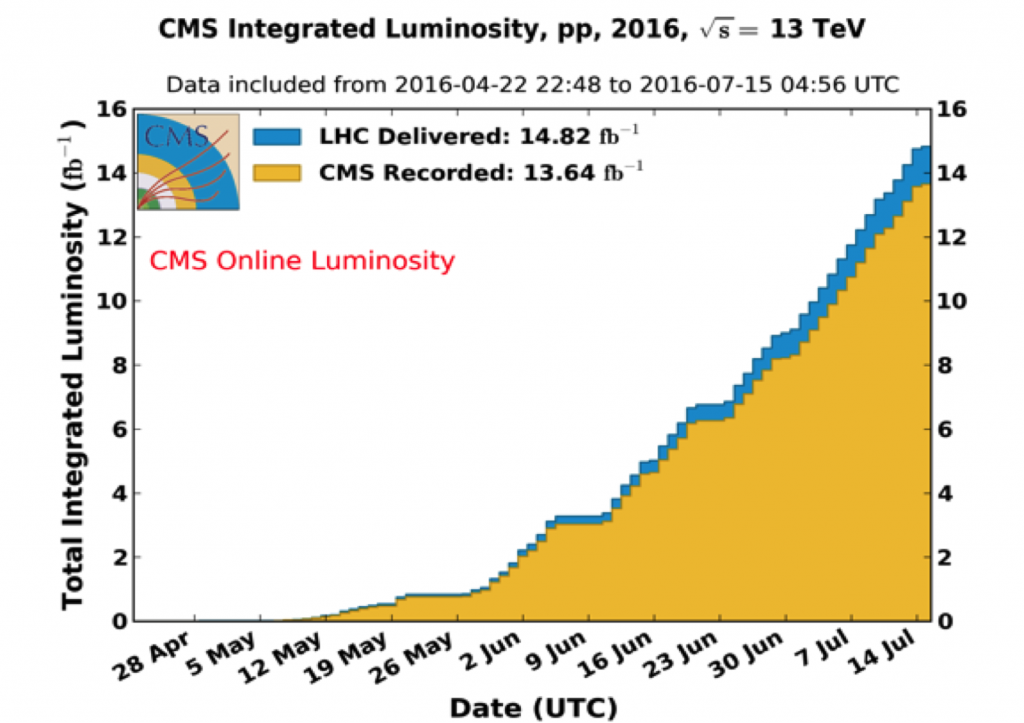
On June 24, the freeze date for preapprovals, CMS had recorded about 6 inverse femtobarns (fb-1) of integrated luminosity (which is a measure of the total number of proton collisions). By July 15, CMS would record more than double that data set.
Data cannot be analyzed immediately after it is recorded. There is an extensive validation process to make sure that no detector malfunctions could be mistaken as physics signals. Then the simulations that are so critical for making measurements must be evaluated against the new data. All of the algorithms used to identify particles must perform similarly in the data and the simulation. To achieve this, the simulation must be adjusted, or scaling factors need to be determined to match the two. All of this work must be completed before any physics measurements can be made.
As a result, at the initial freeze point, only about 4 fb-1 of data were ready for analysis. The data sample to be shown at ICHEP would be triple that size. At the greenlight time, only about 7 fb-1 could be used. This meant that all of the reviews could proceed under only partial information. All along the way, it was possible that something could go wrong as more data was integrated and that any number of analyses could be thrown off track. It would have been nicer if all of the data had been accumulated well in advance, which would have eliminated the race condition, but that was not what we had on our hands.
This meant that all of CMS was racing around too! Within my own research group at Nebraska, we had people participating in all of these activities — helping to record data, validating the simulation algorithms and reconstruction, performing data analyses, and taking part in analysis reviews. But in the days before the conference, everything came together. On August 4, the first day of the ICHEP conference, I awoke to a fuller email inbox than usual. To my delight, I found that there was one email for each result that CMS was releasing for ICHEP. More would come in during the day, and even through the first few days of the conference. In total, CMS presented about 40 new results that used the complete data set, all fully reviewed and published with the full faith of the collaboration.
If the LHC continues to operate well, we could have as much as three times more data by the end of 2016. Fortunately, we will have a bit more breathing room between then and the next round of major conferences. Then we’ll only be in a race with Nature … and our friends on ATLAS.
After more than a decade of running, on June 29, the Main Injector Neutrino Oscillation Search experiment and its second iteration, MINOS+, concluded their runs.
“It is a moment to celebrate the end of a very important program at Fermilab,” said MINOS co-spokesperson Karol Lang, who is at the University of Texas at Austin, during a recent end-of-MINOS reception. “MINOS and MINOS+ have delivered.”
MINOS was the first of its kind at Fermilab, a high-power experiment that shot a beam of neutrinos through two detectors spaced hundreds of miles apart. Neutrinos are tiny, abundant neutral particles that rarely interact with matter. By solving some persistent mysteries of neutrinos, scientists are working to answer questions related to the abundance of matter in the universe or stumble onto new territories in physics beyond the Standard Model.
Over the course of their runs, MINOS and MINOS+ made significant measurements related to neutrino oscillations, a phenomenon in which one flavor, or type, of neutrino switches to another. MINOS’ efforts helped pave the way for new neutrino experiments at Fermilab and elsewhere.
“We delivered on what was expected,” said MINOS co-spokesperson Jenny Thomas of University College London. “We did everything we set out to do and more!”
MINOS fired a beam of muon neutrinos — one of the three neutrino types – from a facility at Fermilab through the MINOS near detector, also located at Fermilab. The beam then traveled 450 miles underground to a far detector in northern Minnesota. The MINOS collaboration measured and compared the number and energy of the neutrino events in the two detectors to study how the muon neutrinos morphed into other types.
MINOS’ closure comes as a suite of other experiments are coming online or beginning construction. The NOvA experiment is Fermilab’s current flagship neutrino experiment and was designed as the successor to MINOS. The Deep Underground Neutrino Experiment (DUNE), a planned international experiment hosted at Fermilab, will spearhead future cutting-edge neutrino research. Apart from these three long-distance experiments, Fermilab also hosts the MicroBooNE and MINERvA neutrino experiments.
“We’ve exploited the beam data as much as we can,” Lang said. “It’s time to move on.”
MINOS was approved for construction in 1995. It was built between 1998 and 2005, during which time it began collecting data from atmospheric neutrinos, which arise from cosmic-ray collisions in Earth’s upper atmosphere. In 2005, Fermilab completed its NuMI (Neutrinos at the Main Injector) beamline. As the name suggests, NuMI provided a dedicated neutrino beam – supplying an abundant, man-made source of neutrinos – for MINOS.
MINOS’ two detectors are massive hunks of magnetized steel and scintillating plastic, stacked in alternating planes and located deep underground. The NuMI neutrino beam struck the 980-ton MINOS near detector, causing the scintillating material to flash with light. That light was translated into a signal the computers could read. The neutrinos then zipped along to the far detector at Minnesota’s Soudan Underground Mine State Park, which hosts an old iron mine 2,341 feet underground. (The depth helped block cosmic radiation that could confuse the interpretation of the beam data). The far detector is even larger — 5,400 tons of metal. It had to be assembled from pieces designed to fit down a four-by-six-foot shaft.
“It took a lot of planning to get those pieces down the shaft and assembled,” said Soudan Mine lab supervisor Jerry Meier of the University of Minnesota. “Working underground has its own unique set of challenges.”
The large size of the detectors increases the likelihood of snagging neutrinos. Neutrinos are highly elusive: even though trillions pass through your body every second, statistically only one will actually interact with your body in your lifetime. More than a trillion man-made neutrinos passed through the MINOS detector every year it ran, but despite its mass, only around 1,500 interacted with the detector in a year.
MINOS’ notable accomplishments included highly precise measurements of several quantities key to understanding neutrino oscillations, including one called the mass difference parameter. It also set constraints for antineutrinos and sterile neutrinos, a hypothetical type of neutrino. It even set limits on models of extra dimensions.
“MINOS really exploited the value of having two functionally identical detectors,” said Stanley Wojcicki, MINOS’ first spokesperson and Stanford University professor emeritus of physics. “It paved the way for this new generation of neutrino oscillation experiments, all of which use this idea.”
When MINOS was first proposed in the early 1990s, scientists had yet to discover neutrino oscillation, although previous research hinted at it. Those who promoted MINOS’ construction dreamed of making the discovery.
“The biggest hopes back then were to actually discover if it’s true, if that’s really the phenomenon occurring in nature,” Lang said.
But in 1998, just as Fermilab began building MINOS, scientists at Super-Kamiokande, a neutrino observatory in Japan, announced that they had discovered neutrino oscillation, a discovery that would be recognized with a Nobel Prize in 2015.
“In one way, it was a disappointment,” Lang said. “But, in another way, it was invigorating that we were really after something new and worth investigating.”
MINOS soon corroborated Super-Kamiokande’s conclusions with its own results, and it set constraints on parameters related to neutrino oscillations. In particular, MINOS measured the mass difference parameter, which is the difference of the square of the masses of two different types of neutrinos. Because the neutrino is so light, scientists can’t measure their masses directly. They can measure only the difference between them. Over the following years, MINOS honed these measurements.
“Measurement of these parameters is incredibly important,” Lang said. “They are part of the fundamental properties of neutrinos, which are, as far as we know, the most abundant constituents of the universe.”
MINOS also branched out into a related area of neutrino research. It was designed only to look for the disappearance of muon neutrinos through their absence in the far detector. But MINOS also took on the challenge of looking for and finding the appearance of electron neutrinos at the far detector.
“The fact that we were able to do it at all is, I think, a technical triumph,” said Fermilab’s Rob Plunkett, MINOS spokesperson from 2006 to 2014.
Later, MINOS was the first to combine disappearance and appearance beam data along with data from the detection of atmospheric neutrinos. This combination of data led to a highly precise measurement of the mass difference parameter that would not be surpassed for years.
From the same data, scientists were also able to examine neutrinos’ antimatter counterparts. The magnetic fields of MINOS’ two detectors could distinguish neutrinos and antineutrinos, a capability that separated MINOS from many other neutrino experiments. Scientists were able to study antineutrino masses relative to those of neutrinos, and they found them to be very similar, as the science had predicted. This information would prove valuable to other neutrino experiments.
MINOS also moved into more exotic territory. It set constraints on the properties of hypothesized sterile neutrinos, a fourth type of neutrino that would interact even less often than the others. And it set limits on extra dimensions proposed by some models of the universe outside standard physics. Some of these models suggest neutrinos disappear into extra dimensions. MINOS found no evidence to support these models during its run, setting a limit on how large those dimensions could be.
MINOS’ second phase, MINOS+, began in 2013. The NuMI beamline provided higher-energy neutrinos, allowing the new MINOS to investigate a different energy region to paint a more complete picture of neutrino oscillation.
Now that it has completed its run, its participants have moved on to other neutrino experiments. At the Soudan Mine, the far detector is being dismantled to be hauled out of the shaft.
“Everything has been moving quite naturally and without big hiccups,” Lang said.
MINOS was supported by the Department of Energy’s Office of Science and was hosted by Fermilab in partnership with the Soudan Underground Laboratory, which is operated by the University of Minnesota in cooperation with the Minnesota Department of Natural Resources. More than 200 people from 30 institutions and six countries participated in the collaboration.
Lang and Thomas acknowledged the special contributions of one of the first co-spokespersons, Doug Michael.
“He was vigorous and pushed everything,” Thomas said. “He made a huge difference. Without him, we never would have got going, I think.”
At the end-of-MINOS reception, scientists from various institutions who worked on MINOS reflected on a decade of pioneering neutrino research and looked forward to research to come.
“We’ve conducted measurements of cross sections and cosmic rays and searched for all kinds of interesting exotic phenomena,” Lang said in a speech at the reception. “We would like to extend our best wishes to the continuing program in long-baseline neutrino experiments, carried now forward by NOvA and in the future by DUNE.”
At the end of the speech, Lang lifted a glass.
“A toast,” he said, “for the great past and even brighter future.”

